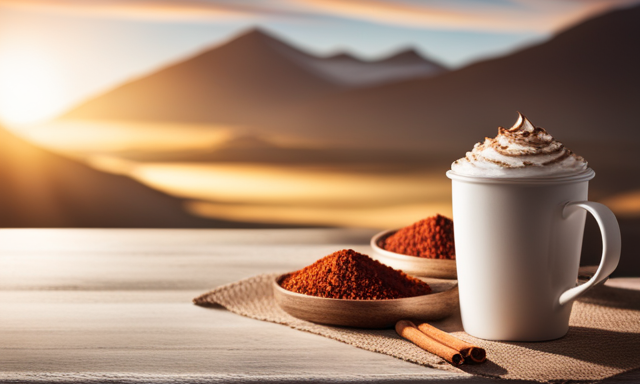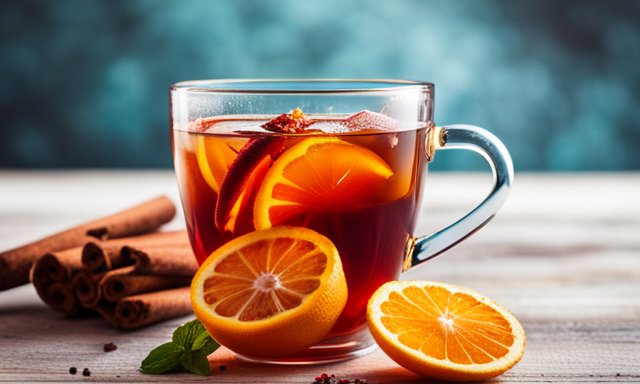Did you know that rooibos tea is not actually tea at all? In fact, it is a herbal infusion made from the leaves of the Aspalathus linearis plant, which is native to South Africa.
With its vibrant red color and unique flavor profile, rooibos tea has gained popularity around the world as a delicious and caffeine-free beverage option.
In this article, I will delve into the origins of rooibos tea, explore its characteristics and health benefits, and discuss the production process and different varieties available. Additionally, I will highlight the culinary uses of rooibos tea and its potential benefits for skin care.
Furthermore, I will touch upon the sustainability of rooibos tea production and how this beverage can be enjoyed while being mindful of the environment.
Whether you are a tea aficionado or simply looking to expand your tea repertoire, join me on this journey to discover the delights of rooibos tea.
Key Takeaways
- Rooibos tea is a versatile type of tea that can be used in various culinary recipes, adding a refreshing twist and complementing natural flavors.
- Rooibos tea offers numerous skincare benefits, including antioxidant properties, anti-inflammatory effects, and the ability to reduce redness and promote brighter, youthful skin.
- The cultivation of Rooibos tea is sustainable, with minimal environmental impact, organic cultivation methods, and reduced water usage to protect the ecosystem.
- Choosing Rooibos tea supports sustainable production methods, as it is grown without pesticides or chemicals, and it also contributes to the economic well-being of local communities through employment opportunities.
Origins of Rooibos Tea
You may be interested to know that the origins of rooibos tea can be traced back to South Africa. Rooibos, which means ‘red bush’ in Afrikaans, is a herbal tea that is made from the leaves of the Aspalathus linearis plant.
This plant is native to the Cederberg region of the Western Cape province in South Africa. The cultivation of rooibos tea involves unique techniques that have been passed down through generations of farmers. The plants are carefully tended to and harvested by hand, ensuring that only the highest quality leaves are used.
After harvesting, the leaves are then fermented and dried in the sun, giving them their distinct reddish-brown color and sweet, earthy flavor. This process is what sets rooibos tea apart from other types of tea.
With its rich history and unique cultivation techniques, rooibos tea has become a beloved beverage worldwide. Now, let’s explore the characteristics of rooibos tea.
Characteristics of Rooibos Tea
Discover the unique qualities of this beloved South African herbal infusion, renowned for its rich flavor and vibrant red hue. Rooibos tea offers a distinctive taste that is unlike any other type of tea. Its flavors are often described as smooth, sweet, and slightly nutty, with a hint of vanilla.
What sets rooibos apart from other teas is that it’s completely caffeine-free, making it a popular choice for those looking for a soothing and relaxing beverage without the stimulating effects of caffeine. This makes rooibos tea a great alternative for individuals who’re sensitive to caffeine or prefer to limit their intake.
In the next section, we’ll explore the health benefits of rooibos tea and how it can contribute to overall well-being.
Health Benefits of Rooibos Tea
Indulging in a cup of this vibrant herbal infusion can provide a multitude of health benefits that contribute to overall well-being. Rooibos tea is known for its antioxidant properties, which help to combat oxidative stress and reduce the risk of chronic diseases. It contains various compounds, such as polyphenols and flavonoids, that act as powerful antioxidants in the body. Additionally, research suggests that rooibos tea may have potential cancer-fighting properties, thanks to its unique combination of antioxidants. These properties can help inhibit the growth of cancer cells and reduce the risk of tumor formation. To illustrate the benefits of rooibos tea, here is a table outlining some of its key health benefits:
| Health Benefit | Description |
|---|---|
| Antioxidant Support | Helps combat oxidative stress and prevent cellular damage |
| Cancer Prevention | May have potential cancer-fighting properties |
| Heart Health Support | Supports cardiovascular health and helps lower blood pressure |
| Digestive Aid | Soothes and aids in digestion, reducing symptoms of indigestion |
| Skin Health Promotion | Promotes a healthy complexion and may help reduce skin inflammation |
Now, let’s delve into the production process of rooibos tea, to understand how this remarkable beverage is made.
Production Process of Rooibos Tea
The production process of rooibos tea involves harvesting the leaves from the Aspalathus linearis plant, which can only be found in the Western Cape province of South Africa. The leaves are then fermented for a specific period of time, typically 12 to 24 hours.
After harvesting, the leaves are bruised and left to oxidize, giving the tea its distinctive reddish-brown color and rich flavor. Once the fermentation process is complete, the leaves are dried in the sun or using specialized machinery to stop the oxidation process.
This careful process ensures that the tea retains its unique flavor profile, which is often described as sweet and slightly nutty, with hints of caramel and vanilla. The resulting tea is caffeine-free and has a smooth, refreshing taste.
Moving on to the next section about different varieties of rooibos tea, it is important to understand the production techniques that contribute to their unique characteristics.
Different Varieties of Rooibos Tea
There are various types of rooibos tea available, each with its own unique flavor and aroma.
-
Traditional Rooibos: This is the classic variety, known for its earthy and slightly sweet taste.
-
Green Rooibos: This type is unoxidized, resulting in a lighter and fresher flavor compared to the traditional variety.
-
Honeybush Rooibos: With a naturally sweet and honey-like taste, this variety is perfect for those with a sweet tooth.
-
Vanilla Rooibos: The addition of vanilla creates a smooth and creamy flavor profile, enhancing the natural sweetness of rooibos.
-
Chai Rooibos: This blend combines the warmth of traditional chai spices with the mellow taste of rooibos, resulting in a comforting and aromatic brew.
In addition to enjoying these different flavors, rooibos tea can also be used in various recipes.
Now, let’s move on to brewing and serving rooibos tea for the perfect cup.
Brewing and Serving Rooibos Tea
When brewing rooibos tea, it’s important to pay attention to the water temperature and steeping time. The ideal water temperature for brewing rooibos tea is around 208°F (98°C), which is just below boiling point. Steeping the tea for around 5-7 minutes allows the flavors to develop fully.
As for adding milk, honey, or lemon to rooibos tea, it’s a matter of personal preference. Some people enjoy adding a splash of milk to make it creamier, while others prefer the natural sweetness of honey. A squeeze of lemon can also add a refreshing citrusy twist to the tea. Ultimately, it’s all about experimenting and finding the combination that suits your taste buds best.
Water temperature and steeping time
Choose a temperature and time to steep your rooibos tea to perfection! When it comes to water temperature, it’s important to remember that rooibos tea doesn’t require boiling water like black or green tea. Instead, it is best to use water that has been heated to around 200°F (93°C). This temperature allows the flavors of the tea to fully develop without becoming bitter.
As for steeping time, rooibos tea requires a longer infusion period compared to other teas. I recommend steeping it for at least 5 minutes, but you can go up to 10 minutes for a stronger flavor.
Once the tea has steeped to your desired strength, you can move on to adding milk, honey, or lemon to enhance the taste.
Adding milk, honey, or lemon
Now that we’ve covered the optimal water temperature and steeping time for rooibos tea, let’s explore the topic of adding milk, honey, or lemon to enhance its flavor.
While rooibos tea is naturally sweet and doesn’t require any additional sweeteners, some people enjoy adding a splash of milk to create a creamy texture and mellow out its earthy taste. If you prefer to avoid dairy, there are various milk alternatives such as almond, soy, or oat milk that can be used instead.
Additionally, rooibos tea pairs well with honey, which adds a touch of sweetness, or a squeeze of lemon for a refreshing twist. These flavor additions can complement the natural flavors of rooibos tea and offer a delightful taste experience.
Moving forward, let’s now delve into the culinary uses of rooibos tea.
Culinary Uses of Rooibos Tea
To enhance your culinary creations, consider incorporating the unique flavors of rooibos tea. This versatile tea can be used in a variety of culinary recipes, adding a delightful twist to your dishes.
Here are three ways you can incorporate rooibos tea into your cooking:
- Infuse rooibos tea into your sauces and marinades for a subtle, earthy flavor that complements a range of dishes.
- Use brewed rooibos tea as a base for soups or stews, adding depth and complexity to the flavors.
- Incorporate rooibos tea into your baking recipes, such as cakes or cookies, for a hint of sweetness and a beautiful reddish hue.
By experimenting with these flavor pairings, you can elevate your dishes and surprise your taste buds with the unique notes of rooibos tea.
Now, let’s explore the benefits of rooibos tea for your skin care routine.
Rooibos Tea and Skin Care
Enhance your skincare routine with the natural benefits of incorporating rooibos tea. Rooibos tea is not only a delicious beverage, but it also offers numerous benefits for your skin.
Rich in antioxidants, rooibos tea helps to protect the skin from damage caused by free radicals, which can lead to premature aging. The tea’s anti-inflammatory properties can soothe irritated skin and reduce redness, making it an ideal choice for those with sensitive or acne-prone skin.
Additionally, rooibos tea contains alpha hydroxy acid, which promotes cell turnover and helps to reveal a brighter, more youthful complexion. Its hydrating properties also help to keep the skin moisturized and supple.
So, if you’re looking to improve the health and appearance of your skin, incorporating rooibos tea into your daily routine is a simple and effective way to do so.
Moving on to sustainability and rooibos tea…
Sustainability and Rooibos Tea
Immerse yourself in the world of sustainability and discover how the cultivation of this vibrant red elixir nourishes both the earth and your well-being.
Rooibos tea, also known as red bush tea, is not only a delicious and caffeine-free beverage, but it’s also grown using sustainable practices that have minimal environmental impact. The cultivation of rooibos tea takes place in the Cederberg region of South Africa, where the plants thrive in the unique climate and soil conditions.
Farmers employ sustainable farming methods, such as organic cultivation and minimal water usage, to ensure the longevity of the land and protect the delicate ecosystem. By choosing rooibos tea, you can enjoy a cup of tea that not only tastes great but also supports sustainable practices.
Transitioning into the subsequent section, let’s explore the delights of rooibos tea and how it can enhance your tea-drinking experience.
Conclusion: Enjoying the Delights of Rooibos Tea
Let’s wrap up and savor the wonderful experience of enjoying the delightful flavors of rooibos tea. This unique tea, indigenous to South Africa, not only offers a delicious and refreshing beverage but also has a wide range of culinary uses.
From adding a subtle sweetness to baked goods and desserts to infusing savory dishes with a hint of earthiness, rooibos tea is a versatile ingredient that can enhance various recipes.
In terms of sustainability, rooibos tea is an excellent choice. It’s grown in a sustainable manner, without the use of pesticides or chemicals, ensuring a minimal impact on the environment. Additionally, the cultivation of rooibos tea provides employment opportunities for local communities, contributing to their economic well-being.
To truly appreciate the wonders of rooibos tea, consider incorporating it into your culinary adventures and supporting its sustainable production methods. Whether you’re enjoying a soothing cup of tea or experimenting with exciting recipes, rooibos tea is sure to delight your taste buds while leaving a positive impact on the planet.
Frequently Asked Questions
How many cups of rooibos tea should I drink per day for maximum health benefits?
I’ve found that drinking 2-3 cups of rooibos tea daily has been associated with numerous health benefits. For example, a woman named Sarah reported improved digestion and reduced stress after incorporating rooibos tea into her routine.
Can rooibos tea be mixed with other types of tea or ingredients?
Yes, rooibos tea can be mixed with herbal blends and various ingredients to create unique flavors. Experimenting with different flavors and spices in rooibos tea allows for a personalized and enjoyable tea experience.
Are there any potential side effects or precautions to consider when consuming rooibos tea?
When consuming rooibos tea, it’s important to be aware of potential allergic reactions and its impact on medication effectiveness. Some individuals may experience allergic reactions, and it may interact with certain medications, so it’s best to consult with a healthcare professional.
Can rooibos tea be enjoyed cold or is it best served hot?
Rooibos tea can be enjoyed cold, providing a refreshing option for those who prefer chilled beverages. However, it’s worth noting that the health benefits of hot rooibos tea, such as antioxidants and potential immune-boosting properties, may be more pronounced when consumed hot.
Is rooibos tea suitable for children and pregnant women to consume?
Rooibos tea is suitable for children and pregnant women to consume. It has numerous health benefits for children, promoting a healthy immune system and aiding digestion. For pregnant women, it can alleviate common pregnancy discomforts and provide essential nutrients.
Conclusion
In conclusion, indulging in the delights of Rooibos tea is like taking a sip of pure serenity. As the warm liquid caresses your taste buds, you’re transported to the rolling hills of South Africa, where the vibrant ruby leaves are harvested with utmost care. With each sip, you can almost taste the sunshine that nurtured these leaves, infusing them with a delicate sweetness and earthy undertones.
Rooibos tea isn’t just a beverage, but a sensory experience that nourishes both the body and soul. So sit back, relax, and let the enchanting flavors of Rooibos tea embrace you in its comforting embrace.










